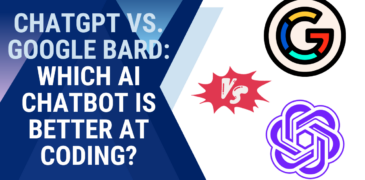In the ever-evolving landscape of artificial intelligence, chatbots have emerged as frontrunners, bridging the gap between human thought processes and machine efficiency. Among the pantheon of these digital wonders, two names have sparked both intrigue and debate: ChatGPT by OpenAI and Google Bard. These AI marvels promise to transform how we approach coding, but a burning question remains: which of these titans truly excels in the realm of coding?
As developers, businesses, and tech aficionados grapple with this conundrum, this article dives deep into a comparative analysis. We’ll dissect their unique architectures, delve into their strengths and weaknesses, and ultimately unravel the enigma of which chatbot holds the crown when it comes to coding prowess. Whether you’re a coding novice or a seasoned developer, this exploration promises insights that might just reshape how you perceive AI in coding.
The Emergence of AI Chatbots: A Deep Dive into ChatGPT and Google Bard
In the swiftly changing landscape of artificial intelligence, two standout chatbots have emerged, advancing technological frontiers and reshaping our dialogue with machines: OpenAI’s ChatGPT and Google Bard. Let’s explore the intricate details and unique features of these two AI powerhouses.
ChatGPT by OpenAI: Revolutionizing Real-Time Communication
Launched in November 2022, ChatGPT has quickly become synonymous with advanced chatbot technology. Below are its distinct features:
Large Language Models (LLMs)
- ChatGPT is built upon the foundation of LLMs.
- These models have been designed to recognize, understand, and generate human language in its various nuances.
Natural Language Processing (NLP)
- NLP empowers ChatGPT to simulate human-like conversations.
- Through this, the bot can effectively communicate in real-time, interpreting user queries and providing apt responses.
Deep Learning & GPT Architecture
- Deep learning allows the model to continuously refine its responses based on vast amounts of data and feedback.
- The GPT (Generative Pre-trained Transformer) architecture, a cornerstone of ChatGPT, facilitates this by processing vast amounts of internet data.
- This ensures the responses generated are not just relevant but also contextually accurate.
Google Bard: The Next Evolutionary Step in AI Communication
Google Bard entered the AI chatbot arena post the rise of ChatGPT, marking its debut in February 2023. Here’s what sets Google Bard apart:
Foundation on LaMDA
- Initially, Google Bard was rooted in the LaMDA language model.
- This was an initial stride towards creating a more conversational and responsive AI.
Transition to PaLM 2
- Recognizing the need for advancement, Google soon transitioned Bard to the more advanced PaLM 2 model.
- This transition marked a significant upgrade, making the bot more versatile and efficient.
NLP & Transformer Technology
- Much like ChatGPT, Google Bard employs the power of NLP to facilitate seamless interactions.
- The added transformer technology ensures the chatbot can mimic human conversational patterns closely.
Web Search Capabilities
- A distinguishing feature, Bard’s web search capability sets it apart from many other AI chatbots.
- This feature enables the bot to pull real-time information from the web, ensuring that the responses are not only accurate but also up-to-date with the latest information available.
Diving Deep: Distinct Features of ChatGPT and Google Bard
When we talk about the pinnacle of AI chatbots, two names come to the forefront – ChatGPT by OpenAI and Google Bard. Both have garnered significant attention for their unique features and capabilities. Let’s dissect and expand on their distinct features to understand each better.
ChatGPT: OpenAI’s Masterpiece
Architecture
- Design Blueprint: ChatGPT is built upon the foundational Generative Pre-trained Transformer (GPT) architecture. The GPT design ensures that the bot can handle a myriad of tasks by leveraging its understanding of language patterns.
Natural Language Processing (NLP)
- Proficiency: ChatGPT is widely recognized for its uncanny ability to understand and mimic human language.
- Reliability: The bot places a significant emphasis on its extensive training data, ensuring it has a vast knowledge pool to pull from when generating responses.
Training
- Data Acquisition: ChatGPT’s knowledge is rooted in the vast amount of internet data it was trained on, up until September 2022.
- Human Independence: An intriguing aspect of ChatGPT’s training is its reliance on pure machine learning, without any human interference or biases.
Applications
- Versatility: Beyond just chatting, ChatGPT is designed to be a multipurpose tool.
- Programming: Aids in code generation and understanding.
- Translation: Provides language translation services.
- Creative Writing: Can generate articles, stories, and more.
Google Bard: Google’s Answer to AI Chatbots
Architecture
- Foundation: Unlike ChatGPT, Google Bard is constructed on the cutting-edge PaLM 2 model. This different foundation endows Bard with unique features distinct from its competitors.
Web Search
- Real-time Data: One of the primary distinctions of Google Bard is its capability to actively search the internet, ensuring its responses are relevant and up-to-date.
- Enhanced Responses: This continuous influx of fresh information allows Bard to craft more accurate and contemporary answers to user queries.
Training
- Diverse Data Sources: Google Bard doesn’t just rely on publicly available data. Its training incorporates a range of data types, including licensed and proprietary data, giving it a broader understanding of various topics.
- Training Depth: The depth and breadth of its training materials provide Bard with a nuanced understanding of user queries.
Integration
- Web Access: A significant advantage is Bard’s default internet access. Users don’t need any premium subscription to leverage this feature.
- Enhanced Capabilities: Over time, Bard has seen an improvement in its functionalities, especially in areas like translation and programming, making it a formidable tool in the AI chatbot arena.
The Core Comparison: Delving Deep into Coding Skills
In the vast universe of AI chatbots, two giants stand tall: ChatGPT and Google Bard. Both present transformative features and have made substantial leaps in conversational AI. But when it comes to coding – a domain renowned for its complexity and intricacies – which of these chatbots truly excels?
Approach to Coding
The method employed by these chatbots to tackle coding problems differs, reflecting their underlying design principles and training.
ChatGPT
- Rooted in Language Understanding: ChatGPT’s strength lies in its profound grasp of languages. This depth translates into an ability to facilitate code generation and tackle problem-solving tasks in the realm of coding.
Google Bard
- Harnessing Web Search: Unlike ChatGPT, Google Bard capitalizes on its search prowess. It actively scours the web, often dipping into various documentation and forums, to present relevant coding-related information to users.
Accuracy in Coding Responses
Accuracy is paramount in coding. A small error can spiral into bigger issues. How do these chatbots measure up in terms of providing precise coding solutions?
ChatGPT
- Knowledge vs Hallucinations: ChatGPT is undeniably knowledgeable, having been trained on vast datasets. However, it isn’t infallible. Especially when faced with intricate coding challenges, ChatGPT might sometimes churn out “hallucinations” or incorrect results.
Google Bard
- Real-time Search vs Generative Errors: Google Bard’s edge is its ability to fetch real-time coding solutions thanks to its web search. Yet, this doesn’t make it error-proof. Being a generative model, it can still err in its predictions.
Reliability for Coders
When developers or coding enthusiasts turn to these chatbots, how reliable can they expect them to be?
ChatGPT
- Conceptual Understanding: ChatGPT shines when you’re looking for a deeper understanding of algorithms or need inspiration for coding ideas. Its comprehensive training allows it to delve into the core concepts efficiently.
Google Bard
- Trend Tracking: Google Bard, with its constant web search, keeps a finger on the pulse of the coding world. As such, it’s aptly suited for those looking to understand the most recent solutions or the latest coding trends.
Integration Capabilities
How seamlessly can these chatbots be integrated into various platforms and tools?
ChatGPT
- Open Ecosystem: ChatGPT stands out with its robust API. This feature ensures developers can seamlessly integrate it across diverse platforms and tools, expanding its use-case scenarios.
Google Bard
- Limited Accessibility: Despite its power and capabilities, Google Bard currently has a constraint. It doesn’t offer direct API access to all developers. While it’s a formidable tool in its own right, this limitation curtails its widespread integrative use, at least for now.
Decoding the Better Choice for Coding: ChatGPT vs. Google Bard
When diving into the realm of AI-driven coding support, two names often come to the fore: ChatGPT and Google Bard. While both platforms promise to revolutionize the coding experience, the question remains: which one is more suitable for coding needs?
Analyzing Core Strengths
ChatGPT
The cornerstone of ChatGPT’s strength lies in its innate ability to understand and generate text. This isn’t limited to just plain English text; it extends to code as well.
- Deep Understanding: ChatGPT has been trained on a vast amount of internet data, which includes coding forums, documentation, and tutorials. This extensive training equips it to grasp the nuances and logic of various algorithms.
- Code Generation: The tool can assist in churning out code snippets, making it a potential aid for developers looking for quick solutions or those facing a coding block.
Google Bard
Google Bard operates somewhat differently. Instead of primarily relying on pre-trained data, its primary strength revolves around pulling the most recent coding information directly from the web.
- Real-time Updates: In the fast-evolving world of coding, where new libraries, frameworks, and best practices emerge continually, having real-time access to the latest information is invaluable. Google Bard, with its search capabilities, taps into this dynamic landscape.
- Diverse Sources: Google Bard doesn’t just fetch data from a single source. It gleans from various platforms, enhancing the breadth and depth of its knowledge.
Specific Use-Cases Decoded
When trying to decide between ChatGPT and Google Bard, understanding one’s specific requirements becomes crucial:
For Algorithm Understanding
- Preference: ChatGPT
- Reason: Algorithms are the backbone of coding, and their understanding requires more than just the latest information. ChatGPT, with its vast training and deep understanding of text, can delve into the intricacies of an algorithm, making it a potent tool for those looking to understand or even implement an algorithm.
For Latest Coding Practices
- Preference: Google Bard
- Reason: Coding isn’t static. With evolving technologies, what’s considered a best practice today might be obsolete tomorrow. Google Bard’s capability to tap into the latest from the web ensures that developers are always aligned with contemporary coding practices.
Also read:
Why Governments Are Turning to Chatbots to Engage with Their Populace
How to Make Money with ChatGPT (12 Easy Ways)
Top 5 AI tools for Chat Solution
Jasper vs ChatGPT: Which one is a better AI based content writing tool?
FAQs
What distinguishes ChatGPT from Google Bard in coding?
ChatGPT primarily relies on its extensive pre-trained dataset and understands code and algorithms deeply. Google Bard, on the other hand, can pull real-time information from the web, keeping it updated with the latest coding practices and trends.
Can either ChatGPT or Google Bard replace human developers?
No, neither of them can replace human developers. They serve as tools to aid coders, offering solutions, generating code snippets, or providing information. Human intuition, creativity, and problem-solving remain irreplaceable in the coding process.
Which of the two offers better integration with other platforms or tools?
As of now, ChatGPT offers a more robust API, allowing developers to integrate it with various platforms and tools. Google Bard, though powerful, has limited API access for developers.
Are there any cost implications for using ChatGPT or Google Bard for coding tasks?
Both ChatGPT and Google Bard have free versions. However, ChatGPT also offers a subscription model, ChatGPT Plus, which provides users with more features and enhanced capabilities at a monthly cost.
How do ChatGPT and Google Bard handle complex coding challenges?
Both have their strengths. ChatGPT can generate code snippets and offers solutions based on its training. Google Bard can search the web in real-time to provide updated solutions or references to similar problems. However, for highly complex challenges, human intervention and expertise are still crucial.
How do these AI chatbots ensure the accuracy of the code they produce or suggest?
While they both are based on advanced AI models and have vast amounts of training data, neither guarantees 100% accuracy. It’s always recommended for developers to review and test any code produced or suggested by these chatbots.
Do ChatGPT and Google Bard support multiple programming languages?
Yes, both chatbots can assist with multiple programming languages. Their versatility stems from their extensive training on various coding forums, documentation, and resources from across the internet.
Conclusion
As the coding landscape continues to evolve at a rapid pace, the emergence of AI chatbots like ChatGPT and Google Bard raises exciting possibilities. These intelligent conversational agents represent a significant leap in how developers access information, generate code, and navigate the intricacies of programming. The question of which one is better for coding is a nuanced exploration, underscoring the dynamic nature of technology.
In this coding face-off, it becomes evident that ChatGPT boasts a profound understanding of algorithms and the ability to generate code. Its strength lies in its extensive training data, making it an invaluable resource for comprehending the core principles of programming. On the other hand, Google Bard thrives in delivering real-time coding information and staying current with the ever-shifting landscape of technology. These tools, while not replacements for human developers, serve as invaluable aids, helping coders meet the multifaceted challenges of the digital age.
In the quest for coding excellence, one must consider not only the current capabilities of these AI chatbots but also their potential for growth and adaptation. As technology continues to advance, the coding journey may well become a collaborative effort, with developers harnessing the power of AI to complement their human ingenuity. Whether you opt for ChatGPT, Google Bard, or a combination of both, the future of coding is undoubtedly intertwined with the endless possibilities that AI-driven chatbots offer.







